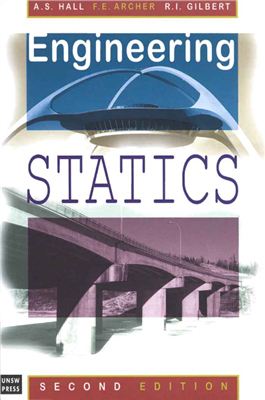University of New South Wales Press, 1999. - 294 pages.
A useful book for anyone interested in engineering mechanics. It is primary intended to be a textbook for undergraduate engineering students and is treasured both for its brevity and clarity of expression.
As in the previous editions, this book deals with the fundamentals of statics and their application to a broad range of engineering problems. The treatment is intended primarily for undergraduate students of civil, structural and environmental en but we hope that it will also be of use to anyone with an interest in engineering mechanics.
The present edition. contains a substantial revision of much of the text of the previous work and several additions to it. We have removed much of the material related to graphical methods of solution, which is now dated and less relevant. Rut in doing so, we have tried to ensure that students can still gain a physical understanding of the solution to particular problems, as well as an analytical one,
A new chapter on fluid statics (Chapter 14) deals with the forces exerted on submerged bodies, as well as with buoyancy and the stability of floating bodies. The chapter on flexible cables (Chapter 9) contains what is believed to be a new approach the analysis of the catenary which allows for the direct solution of many cable problems that have conventionally been solved using trial and error methods. The Appendix has been added, dealing with the geometrical properties of plane figures. These properties have been described and developed by considering some statics problems involving parallel forces acting normal to a plane figure. This approach is directly applicable to
problems in fluid statics and to beam theory that may be studied in subsequent courses. However, the equations are also of general application.
A useful book for anyone interested in engineering mechanics. It is primary intended to be a textbook for undergraduate engineering students and is treasured both for its brevity and clarity of expression.
As in the previous editions, this book deals with the fundamentals of statics and their application to a broad range of engineering problems. The treatment is intended primarily for undergraduate students of civil, structural and environmental en but we hope that it will also be of use to anyone with an interest in engineering mechanics.
The present edition. contains a substantial revision of much of the text of the previous work and several additions to it. We have removed much of the material related to graphical methods of solution, which is now dated and less relevant. Rut in doing so, we have tried to ensure that students can still gain a physical understanding of the solution to particular problems, as well as an analytical one,
A new chapter on fluid statics (Chapter 14) deals with the forces exerted on submerged bodies, as well as with buoyancy and the stability of floating bodies. The chapter on flexible cables (Chapter 9) contains what is believed to be a new approach the analysis of the catenary which allows for the direct solution of many cable problems that have conventionally been solved using trial and error methods. The Appendix has been added, dealing with the geometrical properties of plane figures. These properties have been described and developed by considering some statics problems involving parallel forces acting normal to a plane figure. This approach is directly applicable to
problems in fluid statics and to beam theory that may be studied in subsequent courses. However, the equations are also of general application.

